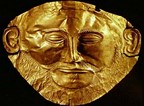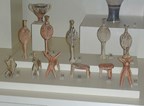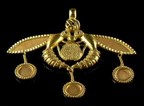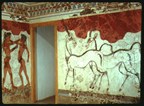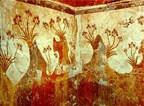Minoan Art:
The initial Greek sculpture, certainly within Europe, dates back towards the Bronze period. On the minute Aegean islet of the Crete, the Minoan Civilization expanded, approximately in similar with old Egypt. For instance, Minoan art depended over a schematic approach that was usually discovered in Egyptian sculpture also. Art was included of carving and painted ceramics until 1500BC, while what’s often described the “Palace Period” appeared and wall painting 1st emerged in Europe, though only fragments exist today. Not like Egyptian art, Minoan art disclose an organic subject matter, which is reproduced in Minoan paintings. Frescoes with Dolphins still hanged in the remaining of the Palace of Knossos, shows a wonderful knowledge about the sea and ocean animals, such as dolphins. Toreador Fresco is another incomplete work of art that remains since the Minoan Society. Summarized in this artwork is 1 of the chronic themes of Minoan art and culture. Contemplation in some means to be linked to Minoan spiritual practices, the picture represents three gymnasts jumping above the horn of a bull. The wall painting is most extraordinary in that it represents a time descend progression, in which you can see the gymnasts holding the bull’s horn, then another mid vault, and the last gymnast landing with limbs outspread.
Mycenaean Art:
Following the Minoan Society, over mainland Greece, the Bronze Era Mycenaean Society was in complete flower. Its legends and history were imprisoned by Homer in his heroic poems, the “Odyssey” and the “Iliad which reproduce the conclusion of the Mycenaean age. 1 of the most lasting artwork from the period is a “Funeral Mask” contemplation to be of Emperor Agamemnon who guides the Greeks toward triumph at the Trojan Wars. All that’s truly called that the golden death facade is from a regal tomb. Remains of Mycenaean work of arts were discovered at 2 sites; Pylos and Tiryns, with situations for everyday life. In compare to Minoan sculpture, Mycenaean was very much solemn in natural world. The Mycenaean society collapsed about 1100BC, spotting the conclusion of the Bronze era and the conclusion of pre history. Towards 650 BC, Greece has appeared as Europe’s most developed society.
Appearance of Greek ceramic:
Following the Mycenaean and Minoan civilization, a record of art of work is almost misplaced in Greek sculpture. Where the Minoans, Mycenaeans and Egyptians utilized frescoes, afterward Greeks tinted over wooden panel that collapses over time, and the major artistic documentation is instead discovered within pottery remaining. Always pottery served a precise use such as drinking vessels, container for perfume, storage jars, etc. On this ceramic, a novel trend was prefigured the Greek obsession over the human shape, that would turn out to be a central design of old Greek sculpture. Exekias is 1 of the most renowned potters, signed minimum 2 of his jobs that linger to this day. In fact, his most renowned “Dyonysos in His Boat” is essential not just because of its right balance, it signals the novel way that symbol would take away from symbol to a style which demonstrates the globe more as it really is. Another modification in the progress of pottery could be observed in the “red figure” method, within which human pictures weren’t tinted but in its place formed while a black backdrop was applied about them, allowing the red soil show through. “The End of the Party” and “Pallas Athena” are 2 crucial instances of this method.
Representing the human figure:
The focus over the human form is 1st seen in Greek ceramic and afterward in art. The depiction of the human-being figure by the Greek within their art-work had a straightforward on its insertion and growth in Roman sculpture, and afterward in Western sculpture in common. The ancient Greek statues, like Kouros were footed over the Egyptian network system. During Mycenaean time, Greek mainland enjoyed the era of prosperity that was centered in strongholds of Mycenae, Thebes, Tiryns, as well as Athens. The local workshops made utilitarian objects of the bronze and pottery, and the luxury items, like carved gems, vases in the precious metals, jewelry, as well as glass ornaments. The contact with Crete played the decisive role in shaping as well as development of the Mycenaean culture, particularly in arts. The wide ranging commerce also circulated the Mycenaean goods throughout Mediterranean world from the Levant and Spain. Evidence consists mainly of the vases, however the contents (wine, oil, as well as other commodities) were the main objects of the trade. Besides getting the bold traders, Mycenaeans were the fierce warriors & good engineers that made & built the remarkable bridges, beehive -shaped tombs and fortification walls —all employing the Cyclopean masonry—as well as elaborate drainage & irrigation systems. The palatial centers, “Mycenae that is rich in gold” & “sandy Pylos,” are all immortalized in the Homer’s Iliad & Odyssey.
The palace scribes employed the new script, of Linear B, in order to record the Greek language. In Mycenaean palace in Pylos—best preserved of kind—Linear tablets suggest that king stood in a head of the well organized feudal system. And by late 14 century BC, the mainland Greece witnessed the wave of destruction as well as decline of Mycenaean sites & withdrawal to remote refuge settlements. Greek life was well dominated by the religion and thus it isn’t very surprising that temples of the ancient Greece were biggest & beautiful. They had the political purpose since they were built to celebrate the civic power as well as pride, and give thanksgiving to patron deity of the city for the success in war.
